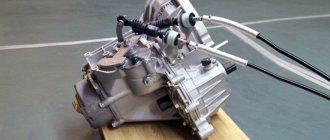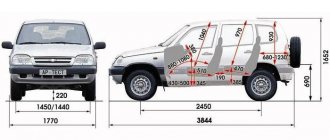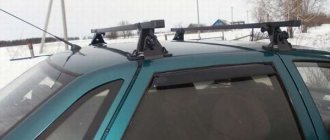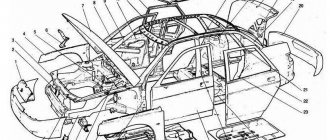Linear dimensions of the cargo compartment of the Lada Largus van
All the sizes you need to know are shown in the photo. The van doors here are fixed at an angle of 90 degrees, but they can be opened all the way to 180. They are fixed in either of the two positions.
Luggage compartment of a Largus van
Let's list everything that is marked in the figure:
- The greatest height of the opening is 92 cm;
- Opening width – 108 cm;
- The distance “from arch to arch” is 96 cm;
- The distance from the edge of the threshold to the partition is 194 cm.
If you lay sheets diagonally, the width of the sheet should be less than 130 cm.
When the partition remains in place, the internal volume of the Lada Largus van is 2540 liters. Load capacity is 725 kg. These figures are indicated by AvtoVAZ.
In fact, the maximum lifting capacity exceeds a ton. It all depends on the road conditions and driving style.
Factors increasing gasoline costs
The main reasons for consuming more fuel are:
- Engine fuel consumption often increases due to low-quality fuel. This happens if you had to use the services of unverified gas stations or “filling up” with gasoline with a lower octane number.
- An important point is the use of additional electrical equipment or unnecessary track lighting. They promote the combustion of large quantities of gasoline in a short time.
- The driving style of the car owner is considered the main factor that affects the gasoline consumption of Lada Largus of all models. To avoid such problems, you need to drive smoothly and brake slowly.
Unfasten the partition or part of it
The partition separating the body and the cabin consists of two halves. They can be removed separately. Both parts are screwed to the body with screws designed for a 13mm key size. Of course, you need a socket wrench.
Screws 1 were hidden under the casing
The four screws on the left and right are located on the cab side. And to unscrew them, remove the casing.
All actions with cladding
The left part of the septum is removed after the right. To remove only the left half, first remove both, and then mount the right sash back. Based on this, immediately decide where you will remove the trim - only on the right or on both sides.
The volume of the body on the Lada Largus van cannot be greatly increased, even if the partition is completely removed. But without the partition, by removing the seat, it will be possible to transport loads 3 meters long.
So, let's start dismantling the trim: you need to remove the seat belt (key “17”), and then unscrew one self-tapping screw. A Torx T20 wrench is suitable for the self-tapping screw.
Cross
The smallest trunk size is in the Largus minivan, designed for 7 seats. The Largus Cross trunk reaches a volume of 200 liters. The manufacturer helped car owners by allowing them to increase the volume of the luggage compartment in liters to 1600–1800, for which two rows of seats should be removed.
The seven-seater version (minivan) has the most “modest” luggage compartment. But the manufacturer met his loyal customer halfway and endowed this modification with a simple secret: it is also possible to increase the luggage space to the same 1600–1800 liters by performing an identical operation to dismantle the stern seats. To do this, you will need to remove two planting rows.
Of course, neither a station wagon nor a minivan are designed to transport large loads, but if necessary, they will cope with this task perfectly.
Increasing the volume of the cargo compartment (removing the excess part on the floor)
The cargo compartment volume of the Lada Largus van can be increased. To do this, remove the floor covering.
There are two types of fasteners here
We will need special Torx keys, without which the screws cannot be unscrewed: Torx T30 and T40.
Study the picture carefully:
- T40 caps (2) are located at the corners, as well as on the line between the arches;
- The remaining screws (1) are designed for Torx T30 keys.
Removing the trim will be easy. And when you install it, make rubber gaskets. They are fixed to the ends of the frame so that the casing does not rust.
The removable floor (cladding) consists of two halves - left and right. First, according to tradition, the right one is removed.
What does the trunk have more: pros or cons?
Summing up the review of the luggage department, it will be useful to take a closer look at the positive aspects and negative aspects. Over such a long period of operation, the owners found only one drawback in Largus. It is due to the fact that the manufacturer was too lazy to adjust the interior of the universal modifications to accommodate the possibility of transporting large items. This is echoed by numerous cases where the transportation of large objects caused damage to decorative components in the interior.
In other cases, grateful owners sing only odes of praise to LADA Largus and its manufacturer. After a thorough study of the advantages of the luggage compartment of a Russian station wagon, our resource has compiled the following list of advantages:
- convenient loading;
- balanced dimensions (space inside and outside characteristics);
- trunk volume quickly increases due to the easy removal of seats;
- enviable carrying capacity;
- competent layout solution of the cargo compartment;
- tendency towards modernization.
Lada Largus technical specifications
Many potential car buyers are interested in the main technical characteristics of the Lada Largus. The car is a clone of the Dacia Logan MCV car of the Renault-Nissan alliance, which has gained some popularity in Europe, redesigned for domestic operating conditions. The Lada Largus model has similar technical characteristics. The car body type belongs to the category of high-capacity station wagons, and the dimensions of the Lada Largus allow the car to be classified both as spacious family cars and ultra-compact commercial vans.
Return to contents
Main body dimensions
The dimensions of the Lada Largus car differ little from those of its competitors, such as Fiat Doblo, Renault Kangoo, Peugeot Partner, Citroen Berlingo, Skoda Roomster, Volkswagen Caddy, Ford Connect Transit. The overall dimensions (body length/width/height) of the Peugeot Partner are 4380/1810/1800 mm, and the body dimensions of the Lada Largus are approximately the same.
Main dimensions of Lada Largus:
- length - 4470 mm;
- width - 1750 mm;
- height (including the dimensions of the roof rails) - 1670 mm;
- car base - 2900 mm;
- front track - 1469 mm;
- rear track - 1466 mm;
- front overhang - 795 mm;
- rear overhang - 770 mm;
- ground clearance under the lowest point of the engine - 145 mm;
- turning radius - 5.62 m.
The Lada Largus body has a hinged rear door. This ensures easy access to the luggage compartment, even in limited parking spaces. The left rear door leaf is noticeably wider than the right one, and the design of the car allows only it to be opened when loading and unloading.
Consumers care whether the Largus body is galvanized. It is known that all steel panels of the machine are double-sided galvanized.
Return to contents
Station wagon engine
The car comes with an 8-valve or 16-valve 4-cylinder fuel-injected engine with multiport fuel injection. The volume of these engines is 1598 cm3; cylinder diameter - 79.5 mm; piston stroke - 80.5 mm; compression ratio - 9.8. The 8-valve engine produces 90 horsepower and a torque of 128 N∙m. The maximum speed of Largus, equipped with such an engine, is 158 km/h, and acceleration to 100 km occurs in 13.4 s. The 16-valve engine is slightly more powerful, it produces 105 horsepower and a maximum torque of 148 N∙m. In this version, the maximum speed is 165 km/h, acceleration to 100 km is 11.8 s.
Lada Largus engines consume gasoline with an octane rating of 95. The car complies with Euro 4 standards. Lada Largus fuel consumption per 100 km in the combined cycle for a 5-seater version and a 16-valve engine is 11.5 liters, and on the highway - 7.6 liters per 100 km.
Basic dimensions
The main indicators of the dimensions of any car, first of all, are understood as the dimensions of the body. Everyone knows that Lada-Largus is a model made on the Renault Dasia Logan MSV platform (2006 variation), but completely adapted for the Russian market. Considering such a relationship between the two cars, it seems surprising that there are some differences in their dimensions, even if they are not significant.
Despite the fact that the Lada-Largus is available in three body variations: a station wagon (5 seats), a minivan (7 seats) and a van (2 seats) - the dimensions of all variations are the same, with the exception of height. More precisely, the machine dimensions are as follows (in mm):
- length – 4470;
- width – 1750;
- width including side mirrors – 2003;
- height – 1636 (station wagon/minivan) and 1650 (van);
- height taking into account restylings - 1670 (station wagon/minivan) and 1686 (van);
- ground clearance - 145-175, which depends on the load of the car (210-170 - for Lada-Largus Cross);
- wheelbase - 2900;
- front track - 1469;
- rear track - 1466;
- front/rear overhangs – 797/771.
Having analyzed the dimensions of the car, we can conclude that the car is quite large for a B-class. Such circumstances emerge not only in theory, but also in practice, judging by the reviews of the owners. Many of them note that the dimensions fit quite well into the aesthetic concept of the car and do not cause any inconvenience during its operation.
Control dimensions of Lada Largus body geometry / Lada Largus
Dimensions of openings and clearances of mating parts of the LARGUS body
| A | B | IN | G | D | E | AND | 3 |
| 1380 ± 5 | 930 ± 4 | 1280 ± 5 | 1155 ± 15 | 925 ± 5 | 975 ± 5 | 1110 ± 5 | 610 ± 3 |
| AND | TO | L | M | N | ABOUT | P | |
| 795 ± 3 | 735 ± 3 | 1530 ± 5 | 800 ± 5 | 1380 ± 4 | 1030 ± 3 | 1140 ± 3 |
Mounting points for suspensions on the body
1 – front subframe mounting points; 2 – shock absorber strut attachment points; 3 – rear subframe mounting points; 4 – guide holes of the front spar; 5 – front guides of the rear spar; 6 – guide holes for mounting the rear suspension; 7 – rear suspension mounting holes; 8 - holes for mounting the rear shock absorber; 9 – rear guide holes of the rear spar.
Scheme for measuring interaxial dimensions
Types of luggage racks
Since three bodies of the Lada Kalina have standard holes for attaching luggage accessories, this means that we can safely distinguish two designs:
- Railings with add-on crossbars and accessories;
- Cross members to factory installation locations.
Well, of course, there are also drivers who only have a universal trunk with a door arch mount. But they haven’t heard about the other models. This is a phenomenon of the owner of Lada Kalina. This means that a universal trunk for them exists and is called third on the list. But they need to keep in mind that the collapsible version of the universal luggage rack is equipped with a trapezoidal platform equidistant from the center of the support. Over-tightening the support bracket will result in strong pressure from the platform on the body. Since the Lada Kalina has a weak corner profile, a dent is possible. Trying to understand the issue is a bit like intimidation. But that's not true.
To date, AvtoVAZ has produced three different bodies:
- Sedan.
- Hatchback.
- Station wagon.
The station wagon has an elongated flat roof, while the sedan and hatchback have a different length and radius. If we correlate the information with the roof rails, then the body type assumes a specific model of the arch. It won’t fit from a station wagon to a sedan, just like from a hatchback to a station wagon. The issue of crossbars is more acute. After all, there are three ways at once:
- A simple stand in standard places. This is a tire made of one three-millimeter steel sheet with two holes for bolts, bent to fit the corner of the roof. At the end there is supposed to be a square hole for a square cross member, and it is known to have poor aerodynamics and whistle at speed.
- Universal non-removable mount. Most have a short catch angle and a thrust pad standing almost next to the center of pressure. Everything would be fine, but then why would there be “original” mounting holes?
- The universal dismountable mount is mentioned above. Its platform puts too much pressure on the roof.
- The third option is when the car is equipped with roof rails.
All that remains is to find the cross members with transitional fasteners for the roof rails. Station wagon Lada Kalina with roof rails
It’s worth resorting to statistics:
- On average, a sedan is equipped with cross members on standard or universal racks. Car enthusiasts are not afraid of noise at speed and dented roofs.
- The hatchback design has better roof rails. If a factory option is not declared, then car enthusiasts search and find a model. Then cross members with adapters are made. By the way, aerodynamic wing-shaped cross members will reduce air resistance from the double structure (rails plus cross members).
- That's why the station wagon is named that way. It is equipped with rails, standard and universal accessories.
Cross members on the roof of a Lada Kalina station wagon.
The owners, in their desire to help the AvtoVAZ concern, are groping for the right path, and the manufacturer reciprocates. We are talking about an optimal trunk with pre-installation of roof rails in their standard places. It is not for nothing that a set of longitudinal bars, if necessary, is ordered immediately from the factory. Some lucky motorists guess, buy roof rails, and then equip them with crossbars and accessories. They look more beautiful. But there are common excuses for those who do not agree with this state of affairs:
- The car is getting taller.
- The noise is louder.
- Aerodynamics suffer.
- The roof with roof rails is difficult to clean.
- The paintwork is destroyed.
- Expensive.
Roof rack with crossbars and mounts for transporting skis on the roof of Lada Kalina
Therefore, reasonable arguments are given:
- One and a half meters plus 15 centimeters is 165 cm. The average height of a person is 175-180 cm. This is not high.
- Wing-shaped cross members reduce noise.
- Any equipment for railings can be quickly removed. Cross members too. Aerodynamics will return to their original values. And the roof rails themselves are already being developed to be aerodynamic.
- The roof with roof rails can be washed easily both in a car wash and by hand.
- The armored film will protect the paintwork.
- Rails allow you to change luggage racks depending on the purpose. Adjusting the distance between the crossbars allows the driver to correctly position the load.
dimensions and dimensions in centimeters, length, width
LADA Largus has long won the sympathy of Russian car enthusiasts. Drivers often pay attention to the large trunk volume of the Lada Largus, which is considered the main advantage of this car. Domestic cars also cope well with another task - providing inexpensive and comfortable travel on modern roads. These two aspects and the ability to accommodate a large number of passengers allowed the car, produced at the Russian AvtoVAZ, to become a popular model in the CIS countries.
The dimensions of the Largus trunk depend on the body variation, it can be:
Advantages and disadvantages
To make the right decision, you need to study not only the advantages, but also the disadvantages of the model. The owners, who have extensive experience in operating Largus, found one drawback. The car manufacturer did not adjust the interior of the station wagons in such a way that their owners would have the opportunity to transport large loads. If the driver nevertheless decided to load a large object into his car, then the cargo often caused damage to the interior.
Otherwise, Lada Largus owners are satisfied with everything in their cars. Among the advantages of a Russian car are the following:
- ease of loading;
- optimal dimensions;
- the ability to increase trunk capacity by removing the seats;
- high load capacity;
- possibility of modernization.
Drivers universally note the practicality and convenience of the LADA Largus trunk. Its size is quite enough to demonstrate the functionality of a domestic car, which allowed it to become a leader among its closest competitors. The manufacturer managed to competently and rationally approach the arrangement of the body space, which allows Largus to successfully transport large objects and indicates the enviable carrying capacity of the model.
Lada Largus is recommended for those drivers who want to get a car with the best consumer properties and technical characteristics.
Technical characteristics of Largus van. Lada Largus van body length
Dimensions of the Lada Largus 2018 van
Dimensions of the Lada Largus van
Russian sales of Lada Largus began in July 2012. The car is available in 7- and 5-seater versions, as well as in a van body.
The car has the following technical characteristics: 8 and 16 valve petrol engine with a volume of 1.6 liters and a power of 87 hp. and 106 hp
The Lada Largus 2021 van has dimensions: 4470 mm in length, 1750 mm in width and 1650 mm in height. The volume of the luggage compartment is 2540 liters.
New video review and test drive of the van:
The station wagon consumes only about 8.1 liters per 100 km in the combined cycle
Tire sizes are 185/70R14, 185/65R15.
See vehicle specifications and prices here.
Technical characteristics of Largus van / MirAvto Lada
Technical characteristics of the Lada Largus station wagon in numbers. For ease of loading, the rear door leaves are fixed in 3 positions 40, 90 and 180 degrees. To properly secure the load, there are 6 mounting points, allowing you to secure even small items. The Lada Largus is equipped with the well-known Renault 1.6 16 valve engines with a power of 102 hp. and 8 valve with a power of 87 hp, only 5 manual transmissions are available. The van's load capacity is 800 kg and the trunk volume is 2540 liters. In the crash test, Largus scored 3 stars out of 5.
Body dimensions of Lada Kalina hatchback
Rice. 1. Control dimensions of door openings. Rice. 2. Body control points in the engine compartment.
Lada Kalina, the body of which is of great interest to motorists today, is considered one of the best creations of the Togliatti plant. Kalina is not a separate model, but a whole family of Russian small-class cars produced since 2004.
VAZ (Lada) Kalina II 2021 - present Got into an accident, the body was in the trash. I want to repair it with my own hands. Tell me, where can I find the geometric (repair) body dimensions of Kalina 2, station wagon, VAZ 219410? Thanks in advance.
Lada Kalina geometric dimensions of the body. Full dimensions with descriptions and drawings. Model: VAZ 1117, 1118, 1119 Kalina.
VAZ body dimensions, body control points, body work instructions.
Tags: body geometry, geometric dimensions, car manuals, car detailing. Hi all! And just a quick correction - PLEASE DO NOT DM ME WITH QUESTIONS ABOUT
Possible sizes of VAZ Kalina bodies: VAZ Kalina (Lada Kalina) is a family of small-class cars in sedan, hatchback and station wagon bodies, which were assembled in Russia from 2004 to 2021. The model was produced in two.
Do the body control points on Kalina 2 coincide with the grant?
Kalina is not a separate model, but a whole family of Russian small-class cars produced since 2004.











